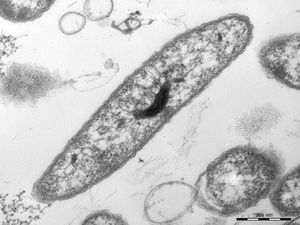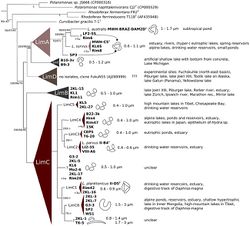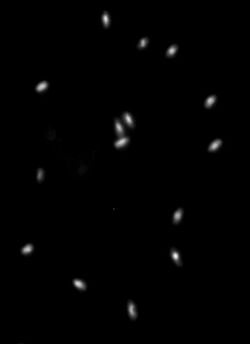Limnohabitans planktonicus
Classification
Limnohabitans planktonicus [plank.to’ni.cus. (from Gr. adj. planktos- wanderer, drifter) planktonicus living in the plankton, planktonic]is a bacterioplankton belong to genus Limnohabitans within the family Comamonadaceae under group Betaproteobacteria.
Domain: Bacteria
Phylum: Proteobacteria
Class: Betaproteobacteria
Order: Burkholderiales
Family: Comamonadaceae
Genus: Limnohabitans
|
NCBI: Taxonomy |
Description and Significance
Gram-negative, rod-shaped, about 0.3-0.4um in diameter and about 0.9um in length Non-motile, unpigmented, oxidase-positive and catalase-positive.
Growth was observed in the temperature range 4-34OC, well-growing under aerobic conditions, weak under anaerobic condition. Grew well on NSY medium, and other commercial media like R2A, Standards Method Agar, TSB, LB Broth, Peptone, Brain Heart Infusion, and Casitone agar, but doesn’t grow on Lowenstein Medium. 1-2 mm large colonies are formed in 2-5 days (at room temperature RT). Growth occurs at a salinity range 0-0.5% NaCl (w/v).
A study done by Hornak et al. 2012, on Limnohabitans planktonicus invading a sample planktonic community, suggests that L. planktonicus may not be detrimental to existing ecosystems at all; in fact, it boosted species diversity in said studies. Although the experimental community was not as diverse as a true ecosystem, it still offers a good hunch about L. planktonicus’s effect on wild freshwater plankton communities, which are ever-changing.
Genome Structure
Partial sequence of the 16S rRNA gene of L. planktonicus has been deposited in the GenBank (accession number FM165535), containing 2,330 bp of linear DNA.
Cell Structure, Metabolism and Life Cycle
L. planktonicus, and its’ entire genus, Limnohabitans, belong to the group of Betaproteobacteria with a greater ability to respond to changing conditions, also known as “metabolic IQ.” This heightened resilience is assumed to correlate with cell volume and genome size. Increased volume and growth potential lead scientists to believe they are opportunistic bacterioplankton, which are more substrate responsive. Most of them were able to use multiple substrates, however, all strains studied by Kasalicky et al. 2013, have had the ability to increase biomass on simple organic acids and sugars.
Ecology and Pathogenesis
The bacterial strain was originally isolated from meso-eutrophic, freshwater column that is also a source of drinking water from the Římov reservoir, located near Ceské Budejovice in Czech Republic, and using the filtration–acclimatization method.
This organism are from R-BT lineage, possess a planktonic (free-living) lifestyle and most R-BT are known to inhabit a broad range of freshwater habitat. They prefer non-acidic stagnant freshwater habitats and comprises typically 5-30% (maximum 50%) of total bacterioplankton in particular habitat.
L. planktonicus is one of the key bacterioplankton group within Betaproteobacteria in freshwater. It is globally distributed and generally abundant in wide array of approximately neutral pH aquatic habitats. This species also displays high growth and substrate uptake rates, but could be limited in nature due to protistan predation.
Due to it’s numerical abundance, this species may be crucial to ecological function in aquatic ecosystems as part of the food web, play role in carbon flow to higher trophic levels as well as help in recycling of dissolved organic matter in aquatic system.
References
http://aem.asm.org/content/76/3/631.full Šimek, K., Kasalicky, V., Jezbera, J., Jezberova, J., Hejzlar, J., Hahn, M.W.. “Broad Habitat Range of the Phylogenetically Narrow R-BT065 Cluster, Representing a Core Group of the Betaproteobacterial Genus Limnohabitans”. “Applied and Environmental Microbiology”. 2010. Vol. 76. no. 3 p. 631-639.
http://www.plosone.org/article/info%3Adoi%2F10.1371%2Fjournal.pone.0058527 Jezbera, J., Jezberová, J., Kasalický, V., Šimek, K., Hahn, M.W.. “Patterns of Limnohabitans Microdiversity across a Large Set of Freshwater Habitats as Revealed by Reverse Line Blot Hybridization.” PLoS ONE 8(3): e58527. 2013.
http://ijs.sgmjournals.org/content/60/12/2710.long Kasalický, V., Jezbera, J., Šimek, K., Hahn, M.W. “Limnohabitans planktonicus sp. nov. and Limnohabitans parvus sp. nov., planktonic betaproteobacteria isolated from a freshwater reservoir, and emended description of the genus Limnohabitans” International Journal of Systematic and Evolutionary Microbiology 2010. Vol. 60 no. 12 p. 2710-2714.
http://www.ncbi.nlm.nih.gov/pmc/articles/PMC3194872/pdf/zam7307.pdf Šimek, K., Kasalický, V. Zapomělová, E. Horňák, K. “Alga-Derived Substrates Select for Distinct Betaproteobacterial Lineages and Contribute to Niche Separation in Limnohabitans Strains” “Applied and Environmental Microbiology. 2011 Vol 77(20): 7307–7315.
http://www.ncbi.nlm.nih.gov/pmc/articles/PMC3520937/ Horňák, K., Corno, G. “Every Coin Has a Back Side: Invasion by Limnohabitans planktonicus Promotes the Maintenance of Species Diversity in Bacterial Communities” PLoS ONE 7(12): e51576. 2012.
http://www.plosone.org/article/info%3Adoi%2F10.1371%2Fjournal.pone.0058209 Kasalický, V., Jezbera, J., Hahn, M.W., Šimek, K. “The Diversity of theLimnohabitans Genus, an Important Group of Freshwater Bacterioplankton, by Characterization of 35 Isolated Strains.” PLoS ONE 8(3): e58209. 2013.
Author
Page authored by Shairah Abdul Razak and Malachi Charles Schuster, students of Prof. Jay Lennon at Michigan State University.
<-- Do not remove this line-->



